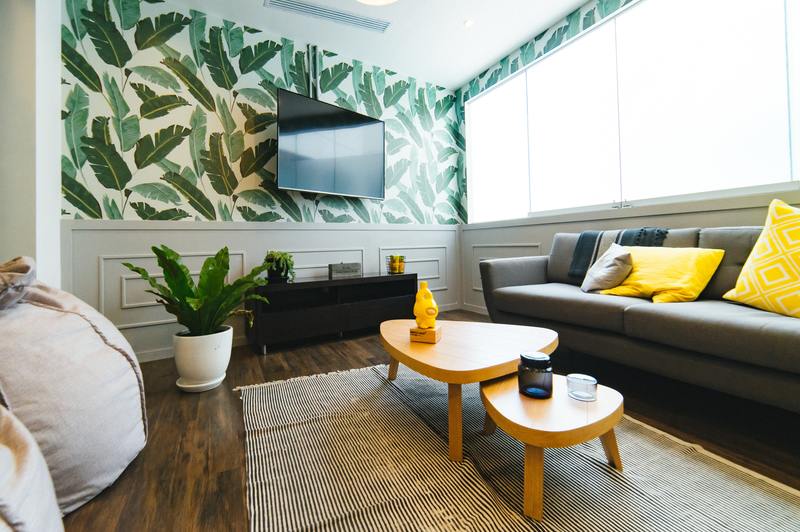After seeing molds in your house walls, you might be wondering how to remove mold from wallpaper. For an extended period, your wallpaper may have areas of mold or mildew growing on it.
Most of the time, removing mold from wallpaper does not provide much of a challenge, but it is essential to act once you discover the problem. If left untreated, these blemishes will only get worse, turning even the most picturesque wallpaper into an eyesore.

Depending on how much mold spores have grown, you may not be able to remove them from wallpaper altogether. If you can determine why the mold is spreading, you can prevent it from returning in the future.
What Causes Mold On Wallpapers?
The wallpaper on the outside walls traps water vapor, which can lead to mold. When it’s hot outside and cool indoors, the situation becomes even more challenging to solve.
Most moistures form on the wallpaper’s side, which eventually leads to mold formation and the decomposition of the drywall.
Moreover, moisture and a food source are two essentials for mold’s growth and development. Mold feeds on paper and glue; thus, the paper acts as a protein source.
If you hang wallpaper in a bathroom or kitchen, you’re inviting dampness into the space. You shouldn’t be surprised to see tiny dark spots start to develop on your wallpaper because of these two variables.
What Are The Signs Of Mold Growth In Wallpaper?
Mold and mildew thrive in warm, damp conditions. That’s why it’s so critical to keep a consistent level of indoor humidity.
A dehumidifier can assist keep your home dry if you reside in a damp area.
Discovering green, brown, orange, or even black spots is the most evident indicator of a mold problem. However, there are less apparent indicators as well:
- The peeling or cracking of paint
- Discoloration
- Repeating “soot” and other black spots on the surface
- Steadily growing
- A wet and musty aroma
Here’s a guide to know what is green mold.
When water vapor encounters a cold surface, it condenses into a liquid, causing mold to grow on your foundation or multi-layers. Mold thrives in bathrooms and laundry rooms because they are frequently damp.
The walls and ceilings near filtration systems and any area with a jacuzzi or bathtub inadequately built indoors are also humid zones. Here’s another helpful guide on how to remove black mold in jacuzzi tub.
How Do You Remove Mold From Wallpaper?
Step #1. A cleaning solution consisting of 1 cup water and 1/2 cup distilled, you should prepare white vinegar ahead of time. Fill a bucket or a spray bottle halfway with this solution.
Alternative cleaning solutions include combining one drop of tea tree oil with 1 cup of water to create a workable cleaning solution.
Step #2. Using a clean sponge, spray the solution, dip it into the container, and squeeze it out well. When cleaning the walls, make sure to put on protective gloves to keep your hands safe.
Step #3. Use a sponge to scrape away the mold from the molded surface gently. Assure the solution doesn’t harm your wallpaper by testing it in an unnoticeable location.
You may try behind a doorway or in the corner of the house. It is safe to proceed if the wallpaper is not damaged.
Step #4. Do not let the sponge wet the wallpaper; instead, move it in little circles. It should be slightly damp but not soggy or waterlogged.
Step #5. Use a soapy sponge soaked in fresh water and a soft towel to wipe down the wall. Before re-washing the wall, let it air dry.
Repeat the process, using only enough product to dampen the area but not so much that it drips. Keep going until the mold is gone.
To avoid bubbles, don’t let your wallpaper become too wet while you clean. Once you’ve eradicated all evidence of mold, thoroughly dry the area.
Remind family members to keep a window open or a fan running as long as visible moisture on the walls.
What Are The Negative Effects Of Mold?
Mold and mildew can have a wide range of effects — from a bit of annoyance to a significant building issue that requires extensive labor to fix. The best part is that it’s usually a matter of appropriate airflow and direct sunlight, rather than a big building problem.
These problems are only severe when they result from inadequate plumbing, faulty weather resistance, or rising moisture. If you have rising damp, it may be a symptom of shoddy construction and necessitate invasive wet proofing procedures.
Removing the floors and delving into the walls may be necessary in some cases. It’s also dangerous for your health because these fungi can cause respiratory problems like asthma or allergies.
Conclusion
We hope you were able to understand how to remove mold from wallpaper. If the mildew is particularly terrible, you may want to hire an expert who can inspect your home and remedy the mold.
As long as the room is well-ventilated and the windows are open, you should be fine.
